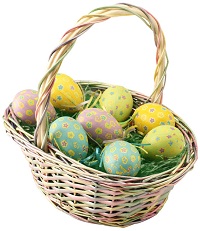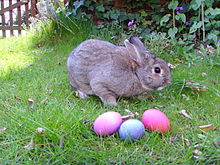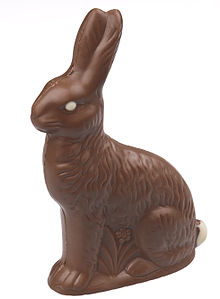
History of the Easter Bunny
 How did we come to associate an egg-laying rabbit with a religious holiday?
The Easter Bunny or Easter Rabbit is usually shown as a rabbit that brings
Easter eggs in a basket to children. Read on for a concise explanation of the history of the Easter Bunny!
How did we come to associate an egg-laying rabbit with a religious holiday?
The Easter Bunny or Easter Rabbit is usually shown as a rabbit that brings
Easter eggs in a basket to children. Read on for a concise explanation of the history of the Easter Bunny!
Origins in Germany
The Teutonic (German) and Saxon deity Eostra was the goddess of spring and fertility, and feasts were held in her honor on the Vernal Equinox (the first day of Spring). Eostra'ssymbol was the rabbit because of the rabbit’s high reproduction rate.
... and England
An Anglo-Saxon legend tells how the goddess Eostre (the root of our word Easter) found a wounded bird and changed in into a rabbit (or hare), so that it could survive the Winter. The rabbit/former bird found (undoubtedly to its surprise) that it could still lay eggs, so rabbit decorated these eggs each Spring and left them as an offering to the goddess who had saved it.
First documented references
The Easter bunny is thought to have first been mentioned in print in Georg Franck von Frankenau's De ovis paschalibus (About Easter Eggs, "Weiser Antiquarian Books - Catalog") in 1682 referring to an Alsace (formerly in Germany, now in France) tradition of an Easter Hare bringing Easter Eggs.
The idea of an egg-laying bunny probably came to the U.S. in the 18th
century. German immigrants in the Pennsylvania Dutch area told their
children about the "Osterhase" (sometimes spelled "Oschter Haws"] "Hase", means "hare", technically not a rabbit, so in northwest
European folklore, the "Easter Bunny" is a hare, not a rabbit. In any
case, according to the legend, only good children received gifts of
colored eggs in the nests that they made in their caps and bonnets before
Easter. In 1835, Jakob Grimm wrote of long-standing similar myths in
Germany itself. Grimm suggested that these derived from legends of the
reconstructed continental Germanic goddess *Ostara. (ref: Grimm, Jacob
(1835). Deutsche Mythologie (German Mythology); From English released
version Grimm's Teutonic Mythology (1888) )
Dutch area told their
children about the "Osterhase" (sometimes spelled "Oschter Haws"] "Hase", means "hare", technically not a rabbit, so in northwest
European folklore, the "Easter Bunny" is a hare, not a rabbit. In any
case, according to the legend, only good children received gifts of
colored eggs in the nests that they made in their caps and bonnets before
Easter. In 1835, Jakob Grimm wrote of long-standing similar myths in
Germany itself. Grimm suggested that these derived from legends of the
reconstructed continental Germanic goddess *Ostara. (ref: Grimm, Jacob
(1835). Deutsche Mythologie (German Mythology); From English released
version Grimm's Teutonic Mythology (1888) )
In the 19th century, German chocolate makers began creating rabbit-shaped chocolates for Easter.
Today's Easter Bunny in Popular Culture
The Easter Bunny is sometimes shown wearing clothes. In legend, the bunny carries his colored eggs in a wicker basket, along with candy and sometimes toys, to the homes of children on Saturday night before Easter Sunday. Commonly in the United States and other English speaking countries, on Easter Sunday, children wake up to find that the Easter Bunny has left them baskets of candy and Hass also hidden plastic eggs filled with candy and/or the eggs that they decorated earlier that week. Children then hunt for the eggs all around the house.
And a popular religious-based children's cartoon (Veggie Tales) created a song about eating the chocolate Easter bunny! You can download "The Bunny Song" as an MP3 here, at the far left! Or get 25 Veggie Tale songs as a cd:
And you can find a history of the Easter Egg here!
Plush Bunny Slippers for Baby Girls
For more information, see the menu bar at the top of the page: Resources and Related Websites
Easter Egg Hunt, Parade and Event Listings
- Deranged Bunny Pajamas from A Christmas Story
-
Easter gift baskets, filled with chocolate and candies
- LEGO Painting Easter Eggs Painting Easter Eggs Set on Amazon
- Mermaid TailBlanket, Soft Crochet Sleeping Blanket for Kids and Adults
- Bag of candy for Easter egg hunts, Hershey and Mondelez Sweet and Sour Assortment
- Filled Easter Basket on Amazon
- Personalized Easter Basket with your child's name on it
- Egg hunt bag of candy: Hershey Chocolate Assortment (270 Pieces) on Amazon
Find Other Family Fun:
Fun Factory tours: factories, places and operations to tour
Road trips and camping resources
Pick Your Own Farms for fruit, veg
Farm markets and roadside stands
Local Honey, apiaries, beekeepers
Consumer fraud and scams information
Home canning supplies at the best prices on the internet!
Maple Syrup Farms, sugarworks, maple syrup festivals
Environmental information and resources
Farms For Your Event for birthday parties, weddings, receptions, business meetings, retreats, etc.
Festivals - local fruit and vegetable festivals
- Egg hunt bag of candy: Hershey Chocolate Assortment (270 Pieces) on Amazon
-
Easter gift baskets, filled with chocolate and candies
- Personalized Easter Basket with your child's name on it
- Already Filled Easter Gift Basket for Kids and Adults (45ct) with Plush Easter Bunny, Candy, Snacks and Treats
- Fuzzy Bunny Slippers, also cows, pigs, monket, etc on Amazon